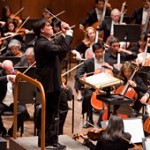by Sedgwick Clark
NOTE: MY BLOG IS NOW POSTED ON THURSDAYS AT NOON RATHER THAN WEDNESDAYS.
Why? The kids aren’t jaded. No repertoire is too daunting. Their enthusiasm nearly always makes up for any momentary technical shortcoming. One skips concerts at Juilliard at his or her peril and often encounters first-rate conductors that the Philharmonic has neglected. Carnegie Hall’s Weill Music Institute just announced a new summer training residency for students from 42 states. Beginning in late June, they will train at Purchase College (N.Y.) and be conducted in their first concerts by Valery Gergiev, with Joshua Bell as soloist in Tchaikovsky’s Violin Concerto. Shostakovich’s Tenth Symphony and a new work by American composer Sean Shepherd complete the program, to be performed at Washington, D.C.’s Kennedy Center, and in Moscow, St. Petersburg, and London (dates tba).
The ensemble’s name, “National Youth Orchestra of the United States of America,” reminds me of a thrilling concert I heard in London in 1977 by the National Youth Orchestra of Britain. Pierre Boulez conducted one of his signature programs: Bartók, Music for Strings, Percussion, and Celesta; Berg, Violin Concerto, with Itzhak Perlman as soloist; Stravinsky, The Rite of Spring. Afterwards, he couldn’t contain his excitement at having conducted The Rite with 146 players. I counted 16 double basses and equivalent numbers in the other string bodies in MUSPAC.
The Berg boasted large orchestral forces as well, but with Boulez’s impeccable ear Perlman soared effortlessly throughout. I had heard Boulez conduct the concerto twice before in concert as well as on record twice, and in each case he downplayed the Viennese dance rhythms in the first movement – but not with Perlman. I saw the violinist at the Aspen Music Festival later that year and asked him how he had gotten Boulez to loosen up. With typical Perlmanian cheer he flipped his right arm in the air dramatically, saying with a grin, “I said, Pierre – dance!”
Some readers may find it odd for me to be essentially reviewing a 36-year-old concert performance, but I just wanted to recall how satisfying a student performance can be. Those British Youths roared through Boulez’s interpretation of The Rite with far more fire than in either of his Cleveland recordings or a later London Symphony performance at Carnegie. I heard several concerts during that three-week stay, but damned if I can remember any of the others.
The critics raved, cluelessly expressing astonishment that the young players were so adept in such “difficult” music – seemingly unaware that the complex rhythms and dissonant harmonies were second nature to their generation. I would like to look forward to the National Youths of the U.S., but for some reason they won’t be playing in New York, just rehearsing in Westchester. Maybe next year.
Chicago’s Legendary Dale Clevenger to Retire
Mahler’s Fifth Symphony begins with a trudging funeral march before bursting out into a wild allegro that climaxes as six French horns whoop up the scale. For over 43 years that rip-roaring moment in a Carnegie Hall performance on January 9, 1970, with the Chicago Symphony under Georg Solti, has remained vividly in my mind. For years thereafter their concerts would be the toughest ticket in town, and at the end of this season, the man leading the horn charge will retire. Dale Clevenger will have been the Chicago Symphony’s principal horn player for 47 years when he moves on to teach at Indiana University. His was a level of artistry I’ll never forget.
Looking Forward
My week’s scheduled concerts (8:00 p.m. unless otherwise noted):
3/11 Carnegie Hall. Stephanie Blythe, mezzo-soprano; Warren Jones, piano. James Legg: Twelve Poems of Emily Dickinson. Barber: Three Songs, Op. 3. American Songbook classics by Ray Henderson, Cole Porter, Edward Confrey, and Irving Berlin.
3/14 Carnegie Hall at 7:00. Orchestra of St. Luke’s/Patrick Summers; Renée Fleming (Blanche), Teddy Tahu Rhodes (Stanley), Anthony Dean Griffey (Mitch), Jane Bunnell (Eunice), Andrew Bidlack (Young Collector), and Dominic Armstrong (Steve). Semi-staged performance directed by Brad Dalton. André Previn: A Streetcar Named Desire.
